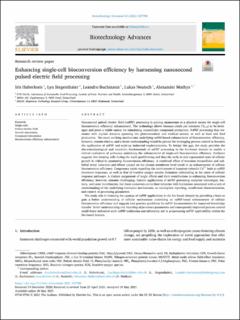Please use this identifier to cite or link to this item:
https://doi.org/10.21256/zhaw-28403Full metadata record
| DC Field | Value | Language |
|---|---|---|
| dc.contributor.author | Haberkorn, Iris | - |
| dc.contributor.author | Siegenthaler, Lya | - |
| dc.contributor.author | Buchmann, Leandro | - |
| dc.contributor.author | Neutsch, Lukas | - |
| dc.contributor.author | Mathys, Alexander | - |
| dc.date.accessioned | 2023-08-04T14:21:55Z | - |
| dc.date.available | 2023-08-04T14:21:55Z | - |
| dc.date.issued | 2021-05-26 | - |
| dc.identifier.issn | 0734-9750 | de_CH |
| dc.identifier.issn | 1873-1899 | de_CH |
| dc.identifier.uri | https://digitalcollection.zhaw.ch/handle/11475/28403 | - |
| dc.description.abstract | Nanosecond pulsed electric field (nsPEF) processing is gaining momentum as a physical means for single-cell bioconversion efficiency enhancement. The technology allows biomass yields per substrate (YX/S) to be leveraged and poses a viable option for stimulating intracellular compound production. NsPEF processing thus resonates with myriad domains spanning the pharmaceutical and medical sectors, as well as food and feed production. The exact working mechanisms underlying nsPEF-based enhancement of bioconversion efficiency, however, remain elusive, and a better understanding would be pivotal for leveraging process control to broaden the application of nsPEF and scale-up industrial implementation. To bridge this gap, the study provides the electrotechnological and metabolic fundamentals of nsPEF processing in the bio-based domain to enable a critical evaluation of pathways underlying the enhancement of single-cell bioconversion efficiency. Evidence suggests that treating cells during the rapid proliferating and thus the early to mid-exponential state of cellular growth is critical to promoting bioconversion efficiency. A combined effect of transient intracellular and sublethal stress induction and effects caused on the plasma membrane level result in an enhancement of cellular bioconversion efficiency. Congruency exists regarding the involvement of transient cytosolic Ca2+ hubs in nsPEF treatment responses, as well as that of reactive oxygen species formation culminating in the onset of cellular response pathways. A distinct assignment of single effects and their contributions to enhancing bioconversion efficiency, however, remains challenging. Current applications of nsPEF processing comprise microalgae, bacteria, and yeast biorefineries, but these endeavors are in their infancies with limitations associated with a lack of understanding of the underlying treatment mechanisms, an incomplete reporting, insufficient characterization, and control of processing parameters. The study aids in fostering the upsurge of nsPEF applications in the bio-based domain by providing a basis to gain a better understanding of cellular mechanisms underlying an nsPEF-based enhancement of cellular bioconversion efficiency and suggests best practice guidelines for nsPEF documentation for improved knowledge transfer. Better understanding and reporting of processes parameters and consequently improved process control could foster industrial-scale nsPEF realization and ultimately aid in perpetuating nsPEF applicability within the bio-based domain. | de_CH |
| dc.language.iso | en | de_CH |
| dc.publisher | Elsevier | de_CH |
| dc.relation.ispartof | Biotechnology Advances | de_CH |
| dc.rights | http://creativecommons.org/licenses/by/4.0/ | de_CH |
| dc.subject | Bioconversion efficiency enhancement | de_CH |
| dc.subject | Compound stimulation | de_CH |
| dc.subject | Growth stimulation | de_CH |
| dc.subject | Pulsed electric field | de_CH |
| dc.subject | Single-cells | de_CH |
| dc.subject | Biomass | de_CH |
| dc.subject | Cell Membrane | de_CH |
| dc.subject | Cell Proliferation | de_CH |
| dc.subject | Electricity | de_CH |
| dc.subject | Microalgae | de_CH |
| dc.subject.ddc | 660.6: Biotechnologie | de_CH |
| dc.title | Enhancing single-cell bioconversion efficiency by harnessing nanosecond pulsed electric field processing | de_CH |
| dc.type | Beitrag in wissenschaftlicher Zeitschrift | de_CH |
| dcterms.type | Text | de_CH |
| zhaw.departement | Life Sciences und Facility Management | de_CH |
| zhaw.organisationalunit | Institut für Chemie und Biotechnologie (ICBT) | de_CH |
| dc.identifier.doi | 10.1016/j.biotechadv.2021.107780 | de_CH |
| dc.identifier.doi | 10.21256/zhaw-28403 | - |
| dc.identifier.pmid | 34048886 | de_CH |
| zhaw.funding.eu | No | de_CH |
| zhaw.originated.zhaw | Yes | de_CH |
| zhaw.pages.start | 107780 | de_CH |
| zhaw.publication.status | publishedVersion | de_CH |
| zhaw.volume | 53 | de_CH |
| zhaw.publication.review | Peer review (Publikation) | de_CH |
| zhaw.author.additional | No | de_CH |
| zhaw.display.portrait | Yes | de_CH |
| Appears in collections: | Publikationen Life Sciences und Facility Management | |
Files in This Item:
| File | Description | Size | Format | |
|---|---|---|---|---|
| 2021_Haberkorn-et-al_Enhancing-single-cell-bioconversion-efficiency.pdf | 1.59 MB | Adobe PDF |  View/Open |
Show simple item record
Haberkorn, I., Siegenthaler, L., Buchmann, L., Neutsch, L., & Mathys, A. (2021). Enhancing single-cell bioconversion efficiency by harnessing nanosecond pulsed electric field processing. Biotechnology Advances, 53, 107780. https://doi.org/10.1016/j.biotechadv.2021.107780
Haberkorn, I. et al. (2021) ‘Enhancing single-cell bioconversion efficiency by harnessing nanosecond pulsed electric field processing’, Biotechnology Advances, 53, p. 107780. Available at: https://doi.org/10.1016/j.biotechadv.2021.107780.
I. Haberkorn, L. Siegenthaler, L. Buchmann, L. Neutsch, and A. Mathys, “Enhancing single-cell bioconversion efficiency by harnessing nanosecond pulsed electric field processing,” Biotechnology Advances, vol. 53, p. 107780, May 2021, doi: 10.1016/j.biotechadv.2021.107780.
HABERKORN, Iris, Lya SIEGENTHALER, Leandro BUCHMANN, Lukas NEUTSCH und Alexander MATHYS, 2021. Enhancing single-cell bioconversion efficiency by harnessing nanosecond pulsed electric field processing. Biotechnology Advances. 26 Mai 2021. Bd. 53, S. 107780. DOI 10.1016/j.biotechadv.2021.107780
Haberkorn, Iris, Lya Siegenthaler, Leandro Buchmann, Lukas Neutsch, and Alexander Mathys. 2021. “Enhancing Single-Cell Bioconversion Efficiency by Harnessing Nanosecond Pulsed Electric Field Processing.” Biotechnology Advances 53 (May): 107780. https://doi.org/10.1016/j.biotechadv.2021.107780.
Haberkorn, Iris, et al. “Enhancing Single-Cell Bioconversion Efficiency by Harnessing Nanosecond Pulsed Electric Field Processing.” Biotechnology Advances, vol. 53, May 2021, p. 107780, https://doi.org/10.1016/j.biotechadv.2021.107780.
Items in DSpace are protected by copyright, with all rights reserved, unless otherwise indicated.